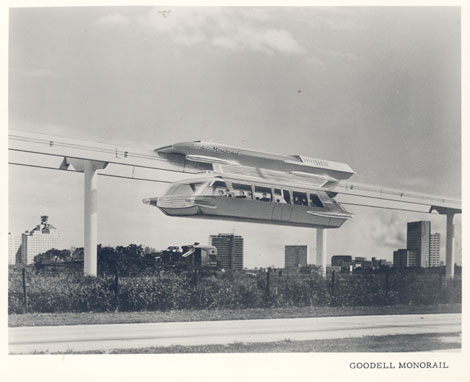The “Never Built” exhibition at the Architecture and Design (A+D) Museum on Wilshire unearths gems from Southern California’s architectural history. The idea originated in 2009, and its extensive research and carefully curated selection by Greg Goldin and Sam Lubell show a Los Angeles of grand gestures in public spaces, landscapes and landmarks. The accompanying publication further documents these projects and many others unable to fit on the walls.
This exhibition is attractive because it shows well-known California architects like Frank Lloyd Wright, Rudolph Schindler, Lloyd Wright, and John Lautner who have been applauded for their built residential work; here we see how they envisioned civic space and commercial buildings. Schindler’s unbuilt gas stations (1933) are a zeitgeist example of modernism—in other words, that once you were designing gas stations, you had “made it” as a modern architect. (FLLW and Mies Van der Rohe, for example, have both built stations.) Archival drawings of Lloyd Wright’s civic center master plan with proposed monolithic structures, transportation scheme and pedestrian corridors were animated in a fly-by video. Lautner’s Griffith Park Nature Center (1972-74) with winged rooflines reach out to soar, yet, budget cuts caused a bland building to be constructed in its place.
Why many of the projects weren’t built is explained with each placard next to the models and renderings. From the Green Blade Tower (2008) by Paris architect Jean Nouvel, where developers paid too much for the land and had to declare bankruptcy, to the simplest, but most vexing of reasons—the design was rejected, as in the case with FLLW’s Doheny Ranch. “Never Built” also tells the story of Rem Koolhaas’ Office for Metropolitan Architecture (OMA) and its design for LACMA in 2001. OMA proposed tearing down the old and rebuilding with an extensive translucent roof built to connect new spaces. Plans were set in motion but they couldn’t get the support of private backers. This provided a clear learning lesson to the institution, which is now trying to raise funds and support for another connective scheme designed by Swiss architect Peter Zumthor.
This exhibit complements the current increased interest both politically and publicly to demand “altruistic” public amenities and rethink the city’s corridors, buildings and civic spaces. There is a need for architectural solutions that merge the history of iconographic architecture with civic excellence. LA’s legacy may be the mastering of movement and the car, but the impact of its designers lay in their visionary ideas.
The “Never Built” exhibition reminds us that this is still a city of visionaries who are continually thinking of the human experience. While there is no direction to what should or shouldn’t have been built (every person is of their own opinion), it is a welcome exhibit of an impressive selection of projects previously hidden. It also exposes, perhaps, a flaw in the system. In Los Angeles there is no lack of ideas, but a scarcity of funding and influence to make these projects happen. Dreams are what made this city, and Angelenos have the power to demand them to be built.


